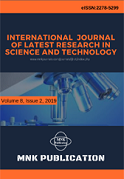DOI:10.29111/ijlrst ISRA Impact Factor:3.35, Peer-reviewed, Open-access Journal
Research Paper Open Access
International Journal of Latest Research in Science and Technology Vol.4 Issue 5, pp 141-148,Year 2015
Correspondence should be addressed to :
Received : 29 September 2015; Accepted : 20 October 2015 ; Published : 31 October 2015

| Download | 126 |
|---|---|
| View | 180 |
| Article No. | 10582 |
The purpose of this paper is to evaluate a variety of current Hot Fusion technologies that have either accumulated a significant amount of research and experimental data to be justifiably selected as a potential fusion device, or have exceptional theoretical breakthroughs behind their ideas to justify a design for future developmental work. Using KPI’s, and Larson’s Hot Fusion Criteria, each selected design will be reviewed andscored relative to theirkey performance indicators and capacity to meet the triple product parametric requirements needed in order to achieve ignition. This obvious method of evaluation has not been attempted before, and will indeed shed some objective insights on the real performance of these current approaches, without the clouded bias of those supporting particular technologies through personal preference. Engineering aspects and the key performance indicators of each device will also be provided so that both the experts and the novices to the field of Hot Fusion can compare and make their own conclusions.
Copyright © 2015 Hossam A.Gabbar et al. This is an open access article distributed under the Creative Commons Attribution 4.0 International (CC BY 4.0) license which permits unrestricted use, distribution, and reproduction in any medium, provided the original work is properly cited.
Hossam A.Gabbar, Daniel Bondarenko, Sayf Elgriw , Anas Abdel Rihem , " Evaluation Of Potential Designs For High Performance Fusion Energy Technologies ", International Journal of Latest Research in Science and Technology . Vol. 4, Issue 5, pp 141-148 , 2015

MNK Publication was founded in 2012 to upholder revolutionary ideas that would advance the research and practice of business and management. Today, we comply with to advance fresh thinking in latest scientific fields where we think we can make a real difference and growth now also including medical and social care, education,management and engineering.

We offers several opportunities for partnership and tie-up with individual, corporate and organizational level. We are working on the open access platform. Editors, authors, readers, librarians and conference organizer can work together. We are giving open opportunities to all. Our team is always willing to work and collaborate to promote open access publication.

Our Journals provide one of the strongest International open access platform for research communities. Our conference proceeding services provide conference organizers a privileged platform for publishing extended conference papers as journal publications. It is deliberated to disseminate scientific research and to establish long term International collaborations and partnerships with academic communities and conference organizers.